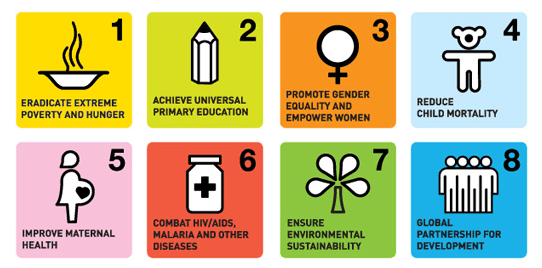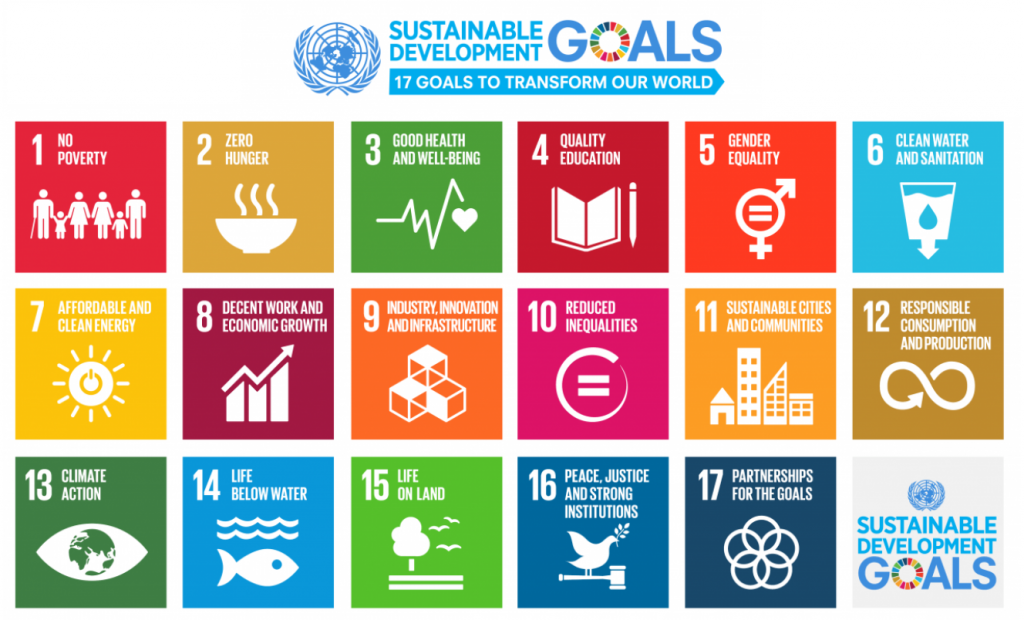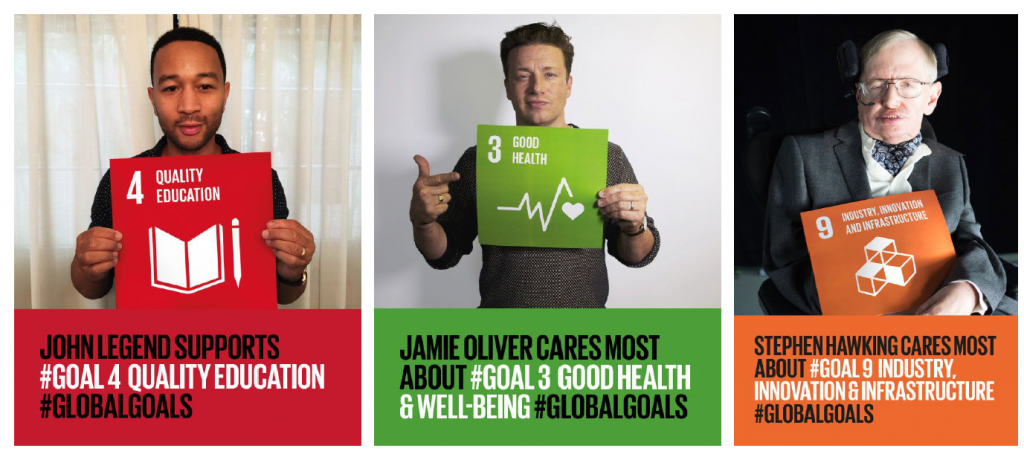The Sustainable Development Goals: A Brief Overview
Öykü KAFALI
Kurumsal İletişim Sorumlusu / Media and Communications Manager
oyku.kafali@izka.org.tr
The ongoing coronavirus pandemic once again showed how the effect people have on one another exceeds national borders and geographical limitations. The precautions one state takes against the spread of the virus, or the lack thereof, have an impact on us all. While this may seem like a disadvantage in the case of a global pandemic, it also provides a chance to form a never before experienced global unity to work towards a sustainable future. This interconnectivity not only accelerates the efforts to find a cure for the virus but also boosts development efforts striving to build a new normal based on solidarity and respect for the environment through encouraging the unity of international public actors and policymakers. Long before the pandemic, the 17 Sustainable Development Goals (SDGs) were identified by The United Nations Development Programme (UNDP) to provide a blueprint to lead this global network of change-makers. Calling all countries to take action for global partnership, the 17 SDGs provide a transnational vision for the future.
A Paradigm Shift in the Concept of Development
To have a better understanding of what the SDGs aim for, an examination of the evolvement of the concept of development is vital. “Development” is a relatively recent term in the political economy literature. It became a prominent concept only after the end of World War II when many former colonies became independent. These newly sovereign countries were politically independent, however; they had to overcome their socio-economic shortcomings. This emerging “underdevelopment” problem then became a highlight in the global agenda. Therefore, development-focused academic work and related policy-making gained traction. These countries not only needed to overcome poverty and improve their economies by achieving industrialization, but they also needed to establish strong government institutions and to ensure the well-being of their citizens. As the approach to development became a sustainability-focused one, factors like human capital, biodiversity, and social inclusion were incorporated as development indicators. This human-centered sustainable development concept, which also focuses on the capability approach contributed by Amartya Sen (Sen, 1990), pioneered a shift in the development paradigm, allowing metrics like employment, human dignity, and education to be taken into consideration while assessing growth.
Background on the Goals

The incorporation of environmental issues within the sustainable development paradigm expanded even further after the 1992 Earth Summit. At the Summit, the international community adopted Agenda 21, a global plan of action emphasizing climate change (UN, 2002). This progress demanded attention to ensuring intergenerational equity by the efficient use of natural resources and called for a shift from a linear economy to a circular one. This ever-growing range of indicators urged transnational organizations like the United Nations (UN) to encourage global unity and to establish an international network of civil society, public institutions, and other related actors to disseminate development efforts. Accordingly, UNDP proposed a blueprint of Goals in 2000 called The Millennium Development Goals (MDGs). These Goals ranged from halving extreme poverty rates to halting the spread of diseases and to providing universal primary education by 2015 as agreed to by the world’s leading development institutions. (UN, 2015)

The Sustainable Development Goals (SDGs) were created as the successor of the MDGs within the 2030 agenda. Both the identification process of these goals and the following implementation efforts is the product of an international network of governmental institutions, NGOs, and civil participation. The SDGs were identified by the UN General Assembly Open Working Group on Sustainable Development Goals, which was established in early 2013. The Member States utilized an innovative, constituency-based system of representation in the Open Working Group and most of the seats were shared by several countries. (UN, 2020) Turkey was represented in the Western European and Others Group, sharing a seat with Italy and Spain. This inclusive intergovernmental process allowed for setting the basis to compensate for the shortcomings of the MDGs as they were criticized for their failure of ensuring global partnership for development and creating a donor-recipient relationship instead (Wilkinson – Hulme, 2012) by encouraging the SDGs to be designed based primarily on partnership and collective action. In fact, Goal 17 was marked as “Partnership for The Goals” (UN, 2020).
The SDGs as a Network of Targets
A further examination of the SDGs reveals that these 17 Goals are all interconnected, completing one another. Each of the Goals incorporates a detailed list of targets that are interdependent. The total of 169 targets defined within the Goals is linked together with both positive interactions as well as tradeoffs. The achievement of Goal 4, “Quality Education”, for instance, will surely boost Goal 5, “Gender Equality” by eliminating gender disparities in education as target 4.5 indicates. Goal 16, “Peace, Justice and Strong Institutions” will stimulate the efforts for Goal 10, “Reduced Inequalities” by ensuring equal access to justice for all as indicated in target 16.3. So, the SDGs can be evaluated as a network with links among goals through the targets (Le Blanc, 2015). A visualization of the matrix of targets and goals provides an overview of their correlation.

Note that as argued by Deleuze & Guattari (1987) in line with their concept of the rhizome, a network is not necessarily just a map. It can have different degrees of centrality and hierarchy, there can either be a rather polycentric, pluralistic, and decentralized structure or there can be central actors that dominate (Fuchs, 2007). The network of SDGs, therefore, is a polycentric one as each one of the Goals is as important as the others and co-dependent on the achievement of one another.
The Role of Collective Action in Achieving the SDGs
Within the SDGs, one in particular aims to stimulate a global network of participation. Goal 17, “Partnership for the Goals”, underlines the necessity of collaborative action and declares that “the Global Goals can only be met if we work together”. This Goal not only emphasizes the importance of intergovernmental solidarity for the achievement of the Goals but also on the importance of encouraging public-private and civil society partnerships. Through forming a network of national, international, and regional stakeholders, Goal 17 mainly aims to establish global solidarity to promote, disseminate, and achieve the 2030 agenda. Calling each and everyone for participation, Goal 17 displays the inclusive nature of the SDGs. The UN works with NGOs, forms regional associations, and interacts with the related government bodies of the Member States. This makes it possible to manage the dissemination, implementation process on a global scale in a geopolitical framework that does not have a supranational authority.
However, civil participation and action are just as vital as the participation of governments or development organizations and institutions. Thanks to the technological advancements that led to the multidimensional transformation of communications systems that have lifted geographical barriers in collective action, this new way of transnational connection has transformed hierarchies into rhizomatic organisms. Collective action no longer requires a leading institution that governs and regulates the process. In a rhizomatic system, the source of power is not a single entity but the network itself. Each network defines its own power system depending on its programmed goals. (Castells, 2004). Therefore, many independent regional SDG networks are able to work for the achievement of the goals all around the world without locational dependency. These civil actors work to spread the word about the Goals and to influence policymakers into implementing regulations for their achievement.

The Impact of New Media on Public Participation
Since political decision making is also said to be dependent on media as emphasized by Castells, today’s advanced digital media tools are the primary push factors in stimulating global action and policymaking for the achievement of the SDGs. In the case of achieving the global adaptation of the SDGs, forming a network of opinion leaders and volunteers is vital to get more people to engage with the 2030 agenda and take action. “If the most important influence in today’s world is the transformation of people’s minds then, the media are the key networks”, Castells notes, underlining the effect of media tools in generating change in ideas and opinions and declares the media as the primary sources of messages and images that reach people’s mind through the distributive networks of global oligopolies (Castells, 2004). Development communication, therefore, focuses on building effective strategies to generate purpose-oriented interaction. Accordingly, the communications strategy for the SDGs is one that makes it easy for the general public to grasp the content of the Goals easily. UNDP utilizes social media tools very effectively, reaching out to a broad audience from every age group and creates effective interaction. Also, to engage stakeholders and the masses, UNDP works with goodwill ambassadors who function as the spokesperson for the organization. By applying one of the prominent communication models, the “Two-Step-Flow” as coined by Paul Lazarsfeld, UNDP reaches out to the masses about the Goals through public personalities. While celebrities like Emma Watson, Serena Williams, and Meryl Streep are global representatives for the program, Mert Fırat is the good-will ambassador for UNDP Turkey.

The feeling of inclusion derived from being a part of global networks of common purpose motivates people to take action to build a better future. As the coronavirus pandemic reminded us of the importance of international unity and collective action, it also emphasized the importance of taking measures for the protection of the environment as well as providing equal social opportunity for all. While the significance of sustainable development is likely to become even more apparent to the masses through the help of media tools, well-communicated agendas like the 2030 SDGs will continue to provide clear roadmaps for the policy-makers to follow.
REFERENCES
- Castells, M. (2004). The rise of the network society. Malden, Mass: Blackwell Publishers.
- Deleuze, G., & Guattari, F. (1987). A Thousand Plateaus. Minneapolis: University of Minnesota Press
- Fuchs, Christian. (2007). Transnational space and the ‘network society’. Twenty-first Century Society. 2. 49-78. 10.1080/17450140601101218.
- Le Blanc, David. 2015. Towards Integration at Last? The Sustainable Development Goals as a Network of Targets. Sust. Dev., 23, 176– 187. doi: 10.1002/sd.1582.
- Sen, Amartya. Development as Capability Expansion. In: Fukuda-Parr S, et al Readings in Human Development. New Delhi and New York: Oxford University Press; 1990.
- United Nations Millennium Development Goals. 2015.
- Wilkinson, R., & Hulme, D. (2012). The Millennium Development Goals and beyond: Global development after 2015. London: Routledge.





